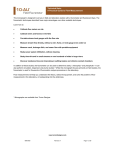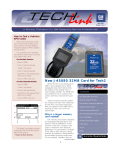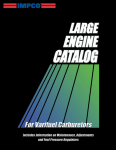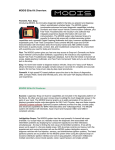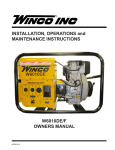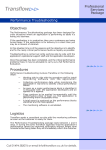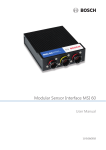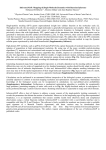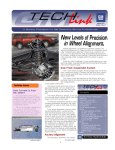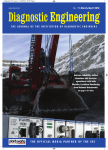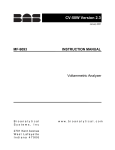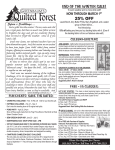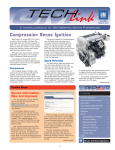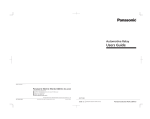Download All-Wheel Drive and 4-Wheel Drive
Transcript
January 2003 Volume 5, No. 1 A Monthly Publication for GM Dealership Service Professionals wheels at one time or another. This is accomplished by attaching a transfer case to the transmission output, to route torque to both front and rear axles. Each axle contains a differential to route torque to right and left wheels. Multi-wheel-drive systems fall into two broad categories, determined by the kind of transfer case used. In all-wheel drive systems, the transfer case has only one speed or range. 4-wheel drive systems all contain a transfer case that has two speeds, called high range and low range. As you will see, understanding the various features, characteristics and operating conditions is no longer a simple task. Operating Characteristics All-Wheel Drive All-Wheel Drive and 4-Wheel Drive General Motors offers a record number of vehicles that are driven by all four wheels. You’ve probably heard them called 4-wheel drive, 4x4s, allwheel drive, 4-wheelers, and possibly others. But the components in these systems are not all alike, their operating principles don’t work alike, and their operating characteristics aren’t alike. The following is intended to clear up some of the confusion. Definitions All multi-wheel-drive systems are capable of providing engine torque to all four Some all-wheel drive systems are called on-demand. Torque is provided to only one axle until its wheels slip. Then, torque is also supplied to the other axle. The decision of when to distribute torque to the second axle, and how much, may be made electronically or mechanically. Another kind of all-wheel drive system is called full-time. In these, torque is supplied to both axles all the time, in various amounts. When wheels on one end continued on page 2 Contents All-Wheel Drive and 4-Wheel Drive . . . . . . . . . . .1 Know-How Broadcasts for February . . . . . . . . . . .2 4T65E Transaxle Conditions . . . . . . . . . . . . . . . .3 Engine Off Natural Vacuum Diagnostic . . . . . . . . .4 Transmission Oil Cooler Flush and Flow Testing Kit 6 Labor Time Guide Redesigned . . . . . . . . . . . . . . .6 Smoke Machine Revisited . . . . . . . . . . . . . . . . . .7 J-45059 Angle Meter . . . . . . . . . . . . . . . . . . . .7 Bulletins . . . . . . . . . . . . . . . . . . . . . . . . . . . . . .8 Vibe driveline is typical On-Demand AWD system Service and Parts Operations 1 continued from page 1 of the vehicle begin to slip, torque is routed to the opposite end, where traction is still present. Although operation of all-wheel drive vehicles is mostly transparent, they can make more noise and have more unusual characteristics than 2-wheel drive systems. There are more parts rotating, and more gears meshing. When an on-demand system engages the second axle, the occupants may hear and feel the components working. The driver may also be aware of sensations and noises when making turns, even on high-traction surfaces where the second axle is not called on to operate. 4-Wheel Drive, Part Time In part time 4-wheel drive systems, torque is normally sent only to the rear axle. When the driver chooses, the front axle can also be engaged. Further, the driver can select between high and low ranges. Some part-time systems also offer an Auto function that selects between 2-wheel and 4-wheel drive modes according to need, without the driver having to do anything. Even in these systems, however, the driver must choose between high and low range. on hard pavement, driveline binding can cause the tires to “crow-hop,” which can be heard and felt. This results because all four of the tires do not rotate exactly the same number of rpm, either side to side or front to rear. Eventually, this difference causes the driveline to begin to bind, or ”wind up,” and one tire or other must temporarily break traction with the pavement to relieve the pent-up energy. On unpaved surfaces, tires can slip as necessary to overcome binding, without causing crow-hop or noise. Running the engine with the transfer case in Neutral may result in noise, and shifting into or out of Neutral can result in some normal gear clash. 4-Wheel Drive, Full Time The automatic 4-wheel drive system provides torque to all four wheels all the time, similar to the all-wheel drive system. But like other 4-wheel drive systems, it also has a low range. The driver can select (depending on the model) 4 HI, 4HI Lock, 4 LO Lock, and neutral. GM TechLink is a monthly magazine for all GM retail technicians and service consultants providing timely information to help increase knowledge about GM products and improve the performance of the service department. Manager, Product Readiness: R. M. (Bob) Savo GM Parts and Service Operations [email protected] Publisher & Editor: Mark Stesney GM Parts and Service Operations [email protected] Technical Editor: Jim Horner [email protected] 1-248-816-3641 Production Manager: In a part-time system, the occupants may feel or hear “something” when the front axle engages. The transfer case makes more noise in 4-high mode than in 2-high mode. And the extra gear reduc- Marie Meredith Desktop Publishing: Greg Szpaichler, MediaWurks [email protected] FAX number: 1-248-649-5465 Typical full-time 4WD transfer case 4-Wheel Drive, Active This system provides the driver with five choices: 2 HI, Auto 4WD, 4 HI, 4 LO, and neutral. These vehicle can be driven continuously in Auto, although there is a fuel economy and noise penalty. Typical part-time 4WD transfer case tion of 4-low mode is prone to making even more noise. Part time systems have no differential or other device to allow front and rear propshafts to turn at different rates. So, if the vehicle is operated in 4-wheel mode When driven in 4-HI or 4-LO, these vehicles can experience crow hopping as well. However, when driven in Auto, the operation of the clutch pack compensates for different driveshaft speeds. All Systems Some noises in these vehicles aren’t new -- they’ve been present in Know-How Broadcasts for February Emerging Issues February 12, 2003 Technology Close-Up February 27, 2003 9:00 AM, 12:30 PM, 3:30 PM EasternTime 9:00 AM, 12:30 PM, 3:30 PM EasternTime Write to: TechLink PO Box 500 Troy, MI 48007-0500 GM TechLink on the Web: http://service.gm.com General Motors service tips are intended for use by professional technicians, not a "do-it-yourselfer." They are written to inform those technicians of conditions that may occur on some vehicles, or to provide information that could assist in the proper service of a vehicle. Properly trained technicians have the equipment, tools, safety instructions and know-how to do a job properly and safely. If a condition is described, do not assume that the bulletin applies to your vehicle or that your vehicle will have that condition. See a General Motors dealer servicing your brand of General Motors vehicle for information on whether your vehicle may benefit from the information. Inclusion in this publication is not necessarily an endorsement of the individual or the company. Copyright© 2003 General Motors Corporation All rights reserved. - Thanks to Tracy Timmerman 2 continued from page 2 unusual or typical is to operate a similar vehicle under similar conditions. It’s necessary to drive the vehicle under conditions that duplicate the customer’s concern. Be sure to try all ranges, in both 2- and 4-wheel drive. Try the Auto range if equipped. Drive in straight lines, and also in circles. Typical active 4WD transfer case 4WD/AWD vehicles all along. But today’s vehicles are made to operate and ride more quietly, so these normal noises and sensations are more noticeable. One way to determine if a noise or condition is 4T65E Transaxle Conditions Owners of 2003 vehicles equipped with the 4T65E automatic transaxle (RPO MN3, MN7, M15, and M76) may experi- TIP: In part-time 4WD systems, it’s important that all tires are the same circumference, to avoid driveline binding, and the resulting crow-hopping. Tires should be not only the same size but also the same brand and type. This is because circumferences can vary a little among brands and types. It may not be much, but it can be enough to cause problems. Proper and even tire inflation is also extremely important and frequently overlooked. And excessive wear of one tire can cause different circumferences. - Thanks to BJ Lackey Current Transfer Case Applications ence harsh shift, TCC shudder during decel, TCC applied in 2nd gear, and DTC P0742. This may be caused by an internal failure of the PWM solenoid. Determine the date code, located on the electrical connector. Replace the solenoid if the date is between 2217 and 2240. The suspect solenoid leaks between the O-rings, shown. Transmissions with build dates before date code 254 (stamped on upper right side of transmission tag) are considered to contain the suspect PWM solenoids. To determine if the solenoid is the cause of the conditions, test drive the vehicle with the Tech 2 connected and monitor Transmission Release Pressure. The status should be YES until TCC applies, then the display should read NO. Suspect the PWM solenoid if the status remains NO during accel, the upshifts are harsh, and the vehicle shudders during downshifts during decel. Another approach is to connect a Tech 2, shift to Drive range and manually apply third gear with the Tech 2. If the engine stumbles and/or stalls, suspect the PWM solenoid. Replace the PWM solenoid (item 334 in the 4T65E Technician’s Guide). The current part number is 24214974, and the Labor Operation Number is K6557. IMPORTANT: Do not replace the valve body if all valves appear to operate freely. - Thanks to Darryl Butler 3 With even a tiny pinhole in the pop bottle or cap, this will not occur because the leak permits the pressure within the bottle to equalize with the air pressure around the bottle. Engine Off Natural Vacuum Diagnostic The EVAP system on a vehicle is intended to prevent evaporated fuel (vapor) in the fuel system from leaking out into the atmosphere. According to OBD II rules, the vehicle must perform self-tests periodically to detect and indicate the presence of leaks. The present standard requires being able to detect leaks as small as 0.020-inch (0.51 mm). The new Engine Off Natural Vacuum (EONV) diagnostic system is used on the following 2003 trucks with V6 and V8 engines: - federal emission vehicles with GVW of 8600 pounds (3900 kg) or less. - California emission vehicles with GVW of 14,000 pounds (6350 kg) or less What’s Different About the EVAP Hardware on EONV Systems Railway tanker collapsed due to trapped vacuum on an empty plastic soda pop bottle and put it in the refrigerator. After a few minutes, look at the bottle. As the air temperature in the bottle drops, so does pressure, indicated by the Previous leak detection methods were performed with the engine running. EONV monitors EVAP system pressure or vacuum with the key off. So it may take up to 40 minutes for the PCM to power down. For the applicable vehicles, the EONV diagnostic replaces only the previous small-leak detection method. All of the other EVAP system component tests are still used during engine operation. These include large leak, restricted vent, excessive vacuum, and others. TIP: This is important to remember when performing a parasitic draw test on vehicles equipped with EONV. Then, after shutdown, the EONV test runs, provided all of the engine-on tests passed. Operating Principles EONV uses the natural pressure changes in the fuel tank to detect leaks. Pressure in a sealed container follows temperature changes. That is, pressure rises when temperature rises. Pressure drops when temperature drops. Actually, none of the hardware has changed. All of the same plumbing, solenoids, valves, and fuel tank pressure/vacuum sensor are the same. The software in the PCM has changed to make the test run, and the canister vent solenoid is wired to battery voltage instead of Ignition 1. Plain bottle, left, collapsed after refrigerating, right partial collapse of the bottle. This is an oversimplified representation of what happens to a fuel tank after shutdown when the fuel and tank cool down. While a vehicle is driven, the fuel in the tank is warmed, even on returnless fuel systems, by warm air from the engine, radiator and exhaust system. Pressure increases in the fuel tank. This is true even in cold ambient temperatures. To avoid battery rundown, the diagnostic limits the number of tests run over a specific period of time. When an EONV test passes, the calibrated time between tests is lengthened. Step-by-Step Operation Although the EONV test runs after engine shutdown, the process actually begins even before the engine is started. That’s because the EONV test can be enabled only after all other engine run- After shutdown, pressure rises for awhile, then eventually drops when the fuel in the tank cools. The EONV system uses the presence or absence of natural pressure changes to detect leaks. If there is even a tiny leak, the expected pressure changes do not occur. In the sealed system, a finite amount of pressure or vacuum will be seen. With a 0.020-inch (.51 mm) leak present, little or no pressure or vacuum is observed. Experiment At room temperature, tighten the cap EVAP system components unchanged 4 ning EVAP tests have run, which requires a long cold-soak shutdown. For all practical purposes, this limits the EONV to occur not more than once per day. A long cold-soak meets these requirements: diagnostic passes, meaning the system is leak-free, and the test is over. The pressure threshold is a function of predicted ambient temperature and fuel level. - start up intake air temperature (IAT) is between 39°-86°F (4°-30°C) - If a vacuum occurs, the diagnostic switches directly to vacuum testing without bleed-down. - start up engine coolant temperature (ECT) is less than 86°F (30°C) - start up IAT and ECT are within 15°F (8°C) of each other After startup, the following must also be satisfied before EONV is enabled: - ambient temperature must be between 40° and 96°F (4° and 35°C). For more information on this, see Sub-Functions below. - fuel level between 15% and 85% full - engine run time, distance traveled, and engine coolant temperature must indicate that the system is adequately warmed up - certain DTCs not present. Refer to SI for specifics. There are three tests that make up the EONV diagnostic: volatility, pressure, and vacuum. Volatility Test -- The EONV diagnostic is very sensitive to large amounts of fuel vaporization due to high volatility fuel. The volatility test makes sure the vaporization rates will not negatively affect the test results. The EONV volatility test runs immediately after key-down if all the enable criteria have been met. The PCM monitors pressure for a calibrated amount of time with the canister vent open and uses preprogrammed values to predict fuel volatility. The logic behind this test is that if pressure builds in the system with the canister vent open, it will certainly be able to mask a 0.020-inch (.51 mm) leak with the vent closed. If the test determines that the volatility of the fuel is high, the PCM aborts the diagnostic. If the fuel is moderately volatile, the diagnostic runs, with compensation for volatility. For low fuel volatility, the diagnostic runs without corrections. Pressure Test -- The pressure test begins by closing the canister vent solenoid and observing the pressure increase inside the fuel tank. At this point, the fuel is still warm enough for some amount of vaporization to occur. - If the pressure increase reaches the calibrated pressure threshold, the - If the pressure threshold is not reached, the PCM records the peak pressure that is reached, and adjusts the vacuum threshold for the vacuum test. Then, the PCM opens the canister vent valve and waits for system pressure to bleed down. The pressure must decay a calibrated amount from the peak pressure for the PCM to consider it a peak, and switch to the vacuum test. The adjusted vacuum threshold equals the difference between the pressure peak and the pressure threshold. Vacuum Test -- During vacuum testing, the PCM closes the canister vent valve and monitors the tank vacuum to determine if the vacuum threshold is reached. - If the vacuum threshold is reached, indicating that the system can hold a vacuum, the diagnostic passes, and the test is complete. not suffice. The PCM: - Uses vehicle speed and airflow to calculate an offset value, which is subtracted from the intake air temperature to predict ambient temperature. - Equates the estimated ambient temperature to intake air temperature for a calibrated amount of time after a cold start. Refueling Determination -- The PCM looks for a net increase in fuel level over the course of a test. The PCM also looks for an abrupt change in vacuum over a calibrated amount of time, as well as changes in fuel level or system pressure that indicate a refueling event. The PCM detects refueling events only when the vent is closed. If a refueling event is detected, the PCM aborts the diagnostic and opens the canister vent. The canister vent must be opened quickly to prevent the canister vent from corking closed. Corking is a condition when the canister vent solenoid is not opened quickly enough, causing pressure in the EVAP system to hold the canister vent solenoid closed. TIP: These individual test results cannot be displayed on the Tech 2. After at least three successful completions, the “pass” flag will display. Rationality Test -- The rationality test determines if the refueling detection was caused by an intermittent signal, or an actual refueling of the vehicle. During the test, the PCM checks to see if the current fuel level is greater than the initial fuel level for a calibrated amount of time. If the calibrated amount of time passes and the PCM is not able to determine whether the fuel level is greater, the refueling event is declared irrational and a DTC is set for the sensor that falsely detected the refueling event. Diagnostic Result Other The PCM quantifies the diagnostic result, incorporating the results of the pressure and vacuum tests. The current result is compared with the previously stored results. If this moves above the fail threshold within the PCM, the MIL is turned on and DTC P0442 is set, indicating a leak larger than 0.020-inch (.51 mm). TIP: Because the PCM remains on during the EONV test, serial data may be observed using the Tech 2. You can watch the vent valve commands and the values from the FTP sensor, for instance. After the PCM completes the EONV test, it powers down and serial data stops. - If the vacuum threshold is not reached, the PCM must compare this with previously stored tests before determining whether to call it a “fail.” This is explained below. Sub-Functions The EONV system must perform several sub-functions to run the EONV diagnostic. Determining Ambient Temperature - The EONV must estimate ambient temperature. Because EONV occurs at the end of the drive cycle, measuring intake air temperature at start-up will 5 TIP: If a customer is going to take their vehicle to an I/M inspection station after service involving clearing DTCs, explain that they should wait four days. The EONV test usually runs only once per day due to the cold-soak requirement. And the I/M status bit “flag” will set ready/complete only after at least three successful completions. - Thanks to Jack Woodward, Chad Lehner and Jeff Kemph Transmission Oil Cooler Flush and Flow Testing Kit GM studies indicate that restricted transmission oil flow is detrimental to the life of any automatic transmission. Plugged oil coolers and oil cooler line restrictions cause insufficient transmission lubrication and elevated operating temperatures which can lead to premature transmission failure. Many repeat repair cases can be prevented by following published procedures for transmission oil cooler flushing and flow checking. J-45096 TransFlow is a transmission oil cooling system flusher and flow tester and will be released in December. A major advantage of this new tool is that it uses conventional Dexron III automatic transmission fluid as the cleaning agent. Unlike earlier oil cooler flushing tools, it doesn’t use detergents, other chemical cleaning agents or hot water, so there is no hazardous waste to dispose of. The J-45096 TransFlow is installed in a wheeled cabinet similar to the ACR 2000 airconditioning service station. It is equipped with: - 32 quart oil supply vessel - 34 quart waste oil vessel - air pressure supply fitting - digital flow rate indicator J-45096-KIT. All of these are itemized and illustrated in the User’s Manual. Contact Kent-Moore at 1.800.345.2233 for additional information. In the flush mode, air pressure forces clean transmission fluid through the oil cooler and lines. This removes dirty oil and blockages. To enhance the cleaning action, the oil is agitated with bursts of air. The cooler is flushed first in the backflush direction, then the normal flow direction. Waste oil is collected in a built-in waste tank. After flushing, use the digital flow rate indicator in the J-45096 to perform a flow test. The User’s Manual includes minimum flow rate charts. TIP: Minimum flow rates vary, depending on whether the oil cooler is made of aluminum or steel. And the flow rates also vary with temperature. Be sure you determine both these facts before performing the flow test. The flow test indicates whether the oil cooler and cooler lines still have restrictions, which must be addressed before the repair is completed. If required, the TransFlow will provide an encrypted 7-digit warranty code following the flow test. The entire flush and flow test procedure takes only 5-8 minutes. - 10-foot 12V DC power cable - 10-foot black supply oil hose with quick connect fitting - 10-foot clear waste oil hose with quick connect fitting The TransFlow equipment is connected to the vehicle’s transmission oil cooler lines using the current cooler line adapters. Two adapters are included with the TransFlow. Five other adapters have been released in the past. And three of the common ones are available in the The waste tank can be emptied either using a suction hose in the port provided or by draining from the built-in drain fitting at the bottom of the tank. In either case, the waste oil can be disposed of the same as any other drained transmission fluid. Procedures in SI will be changed to accommodate the new J-45096 flush and flow tester. - Thanks to Dan Popoff, Russ Dobson and Dave Roland The menu lists the operation categories by letter and by name. If you are unsure of the exact terminology or number, this is probably the best way to conduct your search. Simply click your choice. These names follow SI terminology. Labor Time Guide Redesigned INFORMATION FOR SERVICE MANAGERS AND WARRANTY ADMINISTRATORS IN THE US EXAMPLE: J Engine Effective February 1, 2003, the GM Labor Time Guide will be redesigned. It will now have the same overall appearance and function as other GM service documents, such as SI and owner’s manuals. The new Labor Time Guide will be sent to you on two CDs, one containing the application and the other containing the data. In the future, you will receive updates every second month (months with ‘even’ numbers, such as April, June, etc.). Usage Tips To use the new Labor Time Guide, you must first “build” the vehicle in question. This is done by using pulldown menus to specify model year, make and model. TransFlow connectors In most cases, the next screen presents sub-categories within the broad category. Again, click on your choice. These names also follow SI terminology. EXAMPLE: Engine Mechanical EXAMPLE: 2003 Buick LeSabre Click Next, then click Labor Time Guide. You can now search for specific labor operations three ways. - By name, using common industry nomenclature - By number, if you know it - By menu Spaces are provided for you to type in the name or number. 6 Within the sub-category, your search results are arranged by 5-digit labor codes, followed by the labor operation titles. Click on your choice to see the operation number along with the labor time associated with that number, expressed in hours and tenths. TIP: “Add times” are also displayed when appropriate. - Thanks to Terrie Nicholson and Lisa Scott TIP: You may want to refer to the earlier article first. If necessary, you can find a copy of it on the TechLink website at http://service.gm.com. The EEST was developed to help you locate tiny leaks in the EVAP system, which are defined by OBD 2 as 0.020inch (0.51 mm) or larger. It does this by pressurizing the system with vaporized mineral oil, which appears as smoke when it escapes from a leak. The tool includes a bright light to help you pinpoint the smoke. The EEST is also equipped with a precision flowmeter, to help you determine whether you’ve repaired the leak once you’ve located and fixed it. Using the Smoke Tester Smoke Machine Revisited In the November 2002 issue we covered the operating principles and diagnostic tips for the EVAP system on the Pontiac Vibe and Chevrolet Prizm. This month, we’re covering the EONV system used on some 2003 trucks. So, it’s appropriate to revisit the J-41413-200 Evaporative Emission System Tester (the EEST, or “smoke machine”) which we first covered in the November 2001 issue. Here are some additional pointers you may find useful. J-45059 Angle Meter The new essential J-45059 Angle Meter has just been shipped to dealers. It is used to ensure proper fastener tightness when using the torque-to-angle procedure. The new meter is unlike earlier torque/angle meters in several ways. First, it does not require an anchor arm, so it’s very convenient to use, even in confined places. Second, it does not measure the initial torque, just the final angle. So you’ll use your normal torque wrench, plus the angle meter. A Brief Look at the Science of Tightening Fasteners Friction is the resistance to relative motion between two surfaces. It is present between the threads of a fastener and the threads of a component, and between the bolt head and the surface of the component. When a threaded fastener is tightened with a wrench, up to 90% of the torque applied to the fastener is necessary to overcome friction. Only about 10% of the force is used to hold the components together. This is called clamp load. Fastener friction and clamp load can be affected by thread cleanliness, thread The EEST can be connected to the EVAP system two places, depending on instructions in SI. These are the underhood EVAP service port with the green cap, and the fuel filler neck. You can connect at the service port without disturbing any fittings or connections in the system. TIP: If the leak you’re looking for happens to be between the filler neck and the filler cap, removing and replacing the cap for testing could cause the leak to disappear. TIP: It’s recommended that the fuel tank not be full before performing a smoke test. size, how often the fastener has been used, and the fit of the wrench on the bolt head. Consistent clamp load is always important, but has taken on a new level of concern in modern, lightweight engine components. Ovetightening can lead to distorted parts (such as cylinder bores) and undertightening can lead to leaks and parts coming loose. Torque-to-Angle It’s become fairly common to temporarily assemble parts to the proper clamp load before machining them. For instance, cylinder bores are machined with bore plates bolted and torqued into place on the engine block. Connecting rod and crankshaft bearing bores are machined with the caps torqued into place. When these parts are assembled in the plant, or reassembled in the service department after repair, it’s necessary to apply the same consistent torque to the fasteners to ensure that the parts assume their proper as-machined shapes. When a bolt is tightened, it stretches a 7 This is because in some vehicles, the fuel filler neck enters the tank from the side. If the fuel is above this level, smoke from the service port has to pass through liquid fuel to reach the filler neck and cap. Most or all of the smoke will dissolve in the fuel and may not reach the filler area. So to be sure you’ve tested everything in the system for leaks, it may be necessary to “smoke” the system from both the service port and from the filler neck. Numerous filler neck adapters are supplied for this purpose. Importance of Testing with the Flowmeter Many vehicles do not have an EVAP service bay test to determine if an effective EVAP leak repair has been done. So, the flowmeter in the EEST is the only practical method to be sure you’ve actually located and repaired a small leak. TIP: You will learn in the accompanying article that the EONV small leak self-test will not report a pass/fail until it has run three successive small leak diagnostics. This takes three days of operation, at the very least. Again, use the flowmeter to determine if you’ve made a proper repair. With most systems, using the flowmeter is a good way to prevent comebacks. But with EONV, it’s impossible to know you’ve made an effective repair by any other means. - Thanks to Jack Woodward little. This is called elastic deformation. When the bolt stretches, its clamp load is very predictable. When a bolt turns one revolution, it moves a distance equal to the distance between two adjacent threads. For instance, a bolt with 18 threads per inch moves 1/18inch per revolution. Engineers can determine the amount of stretch a bolt needs, to apply the proper clamp load. This is related directly to the amount the bolt is turned, in degrees. By specifying how far the bolt has to be turned (measured in degrees), after a preliminary torque is reached, the engineers can precisely control clamp load. A typical cylinder head installation may call for tightening the bolts in stages. For instance on the L18 head bolts, first torque to 30 Nm. On the second pass verify 30 Nm and torque 120° in sequence. On the third pass, depending on bolt length: continued on page 8 Bulletins - December 2002 This review of service bulletins released through mid-December lists the bulletin number, superseded bulletin number (if applicable), subject and models. ENGINE/PROPULSION SYSTEM: 01-04-18-001A; replaces 01-04-18-001; Driveline Characteristics for All-Wheel and Four-Wheel Drive Systems; 2003 and Prior LD Truck Models with AWD or 4WD 02-04-21-006A; replaces 02-04-21-006; Inoperative 4WD/AWD Lamps or System; 2002-03 LD Trucks with Electronic Shift or Active Transfer Case (RPO NP1, NP4, or NP8) 02-06-01-022A; replaces 02-06-01-022; Information on Engine Ticking; specified LD Trucks 2002-03 with 6.6L Duramax Diesel Engine (VIN 1 -- RPO LB7) 02-06-03-012; Proper Diagnostic Procedures for No Start, No Crank, Battery, Generator, Gauges, SES, SIR, Brake Security, Theft, ABS, Hot, DIC Messages, Lamp, Light, Diagnostic Testing; 1997-2003 Passenger Cars, LD Trucks, Hummer H2 02-06-04-026A; replaces 02-06-04-026; Engine Backfire and Related Driveability Issues; 1999-2002 Chevrolet and GMC B7 School Bus and C6-7 Conventional Cab MD Models with 7.4L or 8.1L Engine (VINs B, E -- RPOs L21, L18) and IMPCO/Quantum Technologies LPG Fuel System 02-06-04-052; Engine Stalls, No Start, Hard Start (Repair Fuel Pump Feed Circuit); 1990-2002 Chevrolet and GMC H6-7 CSeries MD with Gas Engine 02-06-04-053; Revised DTC P0403 Exhaust Gas Recirculation (EGR) Solenoid Control Circuit; 2000 Chevrolet Venture, Oldsmobile Silhouette, Pontiac Montana with 3.4L Engine (VIN E -- RPO LA1) 02-06-04-055; Vehicle is Difficult to Fill with Fuel (Install Fuel Filler Baffle); 2003 Chevrolet Express, GMC Savana, Except with Left Side Door and Cutaway, Cube and Cab-Chassis 02-06-05-005; Exhaust/Muffler Heat Shield Rattle, Popping Noise Under Vehicle (Install Heat Shield Retaining Straps on Muffler); 2002 Cadillac Escalade, GMC Denali with 5.3L or 6.0L Gas Engine (VINs T, N -- RPOs LM7, LQ9) BRAKES: TRANSMISSION/TRANSAXLE: 02-05-22-004B; replaces 02-05-22-004; Trailer Brakes Applied When Headlights/Park Lamps Are On, Brake Controller Illumination (Modify Brake Controller Wiring Harness) specified 200203 LD Trucks and Hummer H2 02-05-27-001A; replaces 02-05-27-001; Antilock Brake System (ABS) Indicator Illuminates When Power Takeoff (PTO) is Engaged (Replace Electronic Brake Control Module EBCM); specified 2001-02 Chevrolet and GMC Trucks with Air Antilock Brakes (RPO JE5) and Allison Auto Transmission 02-07-30-032A; replaces 02-07-30-032; Allison Transmission Control Module FastLearn Procedure Update Required After Transmission Repairs; 2002-03 Chevrolet Silverado, GMC Sierra with Allison 1000 Series Automatic Transmission 02-07-30-040; Difficult Shifting from Park to Drive Range (Replace Shift Indicator Slide within Floor Console); 2001-02 Pontiac Aztek 02-07-30-042; Allison Transmission Service Repairs; specified 2003 Chevrolet Kodiak and GMC TopKick models with Allison 1000-2400 Series Transmission GENERAL INFORMATION: 99-00-89-015B; replaces 99-00-89-015A; Light Service Support Vehicle (LSSV); 19992003 Chevrolet Silverado, Suburban, Tahoe 4WD Models with Military Upfit HVAC: 02-01-39-007; Automatic Dual Zone HVAC Battery Draw; 2003 LD Trucks and Hummer H2 STEERING: 02-02-32-012; Rattle/Knock Noise When Turning While Driving Over Rough Roads (No Fix at This Time, Fix Under Development); 1999-2002 Chevrolet Cavalier, Pontiac Sunfire SUSPENSION: 01-03-10-012A; replaces 01-03-10-012; Guidelines for Using E2020 Wheel Alignments, E2000 Toe Adjust and E0200, E0201, E0203, E0204 Wheel Balance; 19892003 Passenger Cars and LD Trucks, 2003 Hummer H2 DRIVELINE AXLE: 02-07-30-043; Allison Transmission Service Repairs; 2001-03 Chevrolet Silverado and GMC Sierra HD 2500 and 3500 with Allison 1000 Series Auto Transmission (RPO M74) 02-7-30-048; Pressure Control Solenoid Replacement for 4T65-E, 4T40-E and 4T45E Transaxle/Transmission; specified 2000-03 vehicles with RPO Codes MN4, MN5, M13, M15, MN3, MN7 OR M76 BODY AND ACCESSORIES: 02-08-42-005; Snowplow Roof Beacon (Lamp) Inoperative (Install Bypass Harness); 2003 Chevrolet Silverado, Suburban, Tahoe, GMC Sierra, Yukon, XL with Snow Plow Provision (RPO VYU) and Roof Mounted Lamp Provisions (RPO TRW/5G4) 02-08-44-018; Diagnostic Information for No Audio Out of Speakers on One or More Channels; 2003 Cadillac Escalade, Chevrolet Silverado, Suburban, Tahoe, GMC Sierra, Yukon, XL, Hummer H2 with Premium Bose Sound Systems 02-08-46-010A; replaces 02-08-46-010; Programming OnStar Module for Canadian French Voice Recognition; specified 2003 Passenger Cars, LD Trucks, Hummer H2, with OnStar 02-08-48-001; Stationary Glass Urethane Adhesives -- Additional Materials Recognized; 2003 and prior Passenger Cars and Trucks, 2003 Hummer H2 02-08-49-004A; replaces 02-08-49-004; Instrument Panel Cluster (IPC) Gauges Read Zero at Times, Gauges Inop at Times (Reprogram (PC); 2002 Chevrolet TrailBlazer, EXT, GMC Envoy, XL, Oldsmobile Bravada 02-08-63-003; Bumper Fascia Cover Retainers Pulling Out of Fascia (Trim Fascia); 2002-03 Chevrolet Avalanche 02-08-64-022; Cycling Power Folding Mirror to Remain in Locked Position After Transport; 2003 LD Trucks with Power Folding Exterior Mirror (RPO DL3), Hummer H2 with Power Folding Exterior Mirror (RPO DL7) 02-08-110-006; Revised Sunshade Replacement; 2002-03 Chevrolet TrailBlazer, EXT, GMC Envoy, XL, Oldsmobile Bravada 02-08-127-001; Availability of Rear Parking Assist Sensor Service Harness; 2001-03 Chevrolet Venture, Oldsmobile Silhouette, Pontiac Montana J-45059 Angle Meter from page 7 - tighten bolts 1, 2, 3, 6, 7, 8, 9, 10, 11, 14, 16, 17, an additional 60° - tighten bolts 15 and 18, an additional 45° - tighten bolts 4, 5, 12, 13, an additional 30° Measuring the tightening in degrees is the purpose of the J-45059 Angle Meter. Using the J-45059 Angle Meter These are the highlights. Refer to the instructions that come with the meter for full details. The J-45059 Angle Meter is designed for use with a standard 1/2-inch drive extension and a ratchet or torque wrench. TIP: The bolt must already be tightened to the specified initial torque before final angle-tightening. Begin by turning the meter on; the last-set value will display. Use the up/down arrows to set the display to the desired angle value. The range is 0-199° in 1° increments. Attach the meter to the 1/2-inch extension, as close as practical to the socket, 8 using the spring-loaded clamp. Install the socket to the bolt. Without turning the bolt, apply pressure in the direction of tightening to remove all free play from the wrench. Then press the On/Zero button and hold until the meter sounds a short beep and flashes. Tighten the bolt. When the preset angle is reached, the meter sounds a long beep and flashes. After use, the meter will shut itself off within a minute to conserve battery power. - Thanks to Tracy Flood and Ron Minoletti








